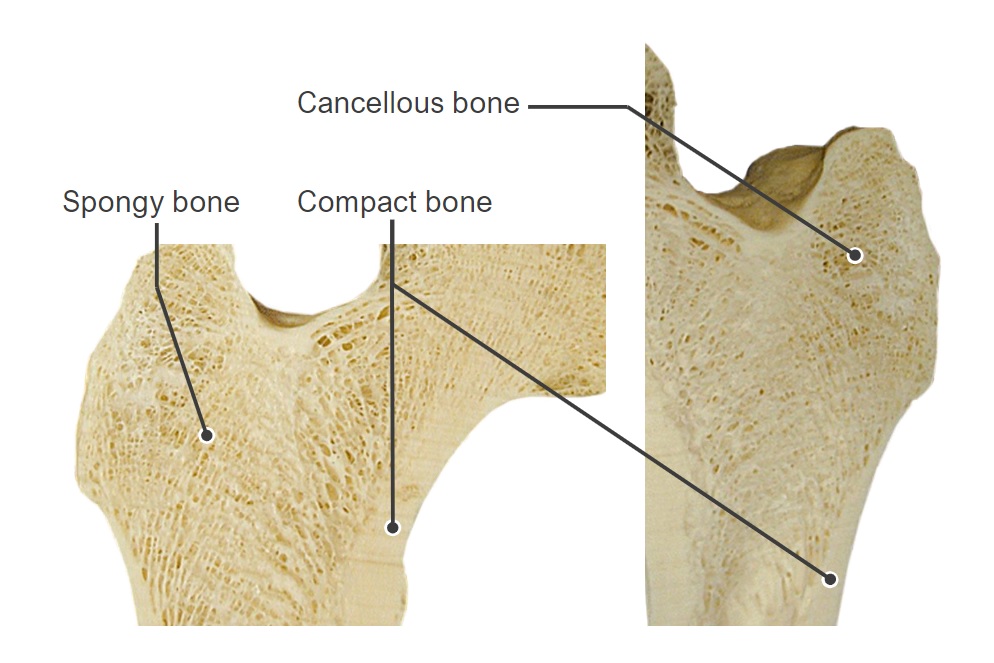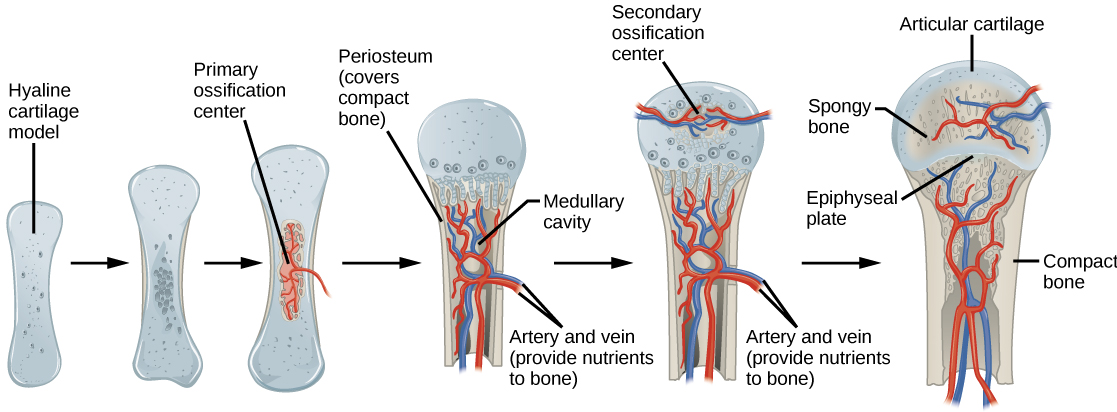Playlist
Show Playlist
Hide Playlist
Bone: Structure and Function
-
Slides 01 Bone MusculoskeletalSystem.pdf
-
Download Lecture Overview
00:01 Bone and the skeletal system. 00:05 The structure and function of bone is very important in understanding how the process it will be to both store calcium and phosphate and also provide structure so the muscles can pull on these bony levers so you can ambulate or walk around. 00:23 Let’s take a long bone as an example, talk through some of these salient features, and then we will start to look at the different types of bone. 00:32 When we look at the long bone structure, it’s important to think about a couple of items, the first is cortical bone. 00:41 Cortical bone is the top layer of hard bone that’s across the shaft of the long bone. 00:50 Trabecular bone is the spongy kind of lattice network of bone that’s usually located in the upper portions of the long bone. 01:01 Then you have marrow, which is located throughout the shaft of the bone. 01:07 Why do you have these two different types of bone? I think the best way to think of this is that there is an engineering feat being done here. 01:17 What you need is the hardest bone you can have to have structural integrity for the body to provide support to pull on, but it needs to be as light as possible. 01:32 If this was just solid cortical bone, it would be so heavy, it would be hard to move around. 01:39 The trabecular bone, although it’s not as strong, is nice because it provides an avenue in which there is less weight involved. 01:49 So you’re always playing a game between putting down more calcium and phosphate versus taking some of it away so that you can optimize this strength versus weight component. 02:06 How do you form bone to start with? The first thing that you need is collagen. 02:13 Collagen is a type of connective tissue and you can run collagen up and down, add ground substance to it. 02:23 Think of ground substance as more like the cement around the collagen, which are kind of act like rebar. 02:32 Rebar is what provides structural support for a building. 02:36 That’s that iron bars that are placed so that they can bend a little bit, but still provide structural support. 02:44 Then what do you need? You need crystals to form. 02:48 It’s hard to get crystals to form in ground substance. 02:52 So what you do is you supersaturate it with the calcium and phosphate. 02:57 Eventually, they form crystals and it’s them crystals that will be hard enough to form bone. 03:05 Then you need to have it mature, and over time, the bone will mature and calcify to a greater degree. 03:12 It takes a while for bone to get into this mature process, and therefore, have enough calcium and phosphate in it. 03:23 So what really is bone? Well, about 30% of it is organic material. 03:30 And what do we mean by organic material? Two percent of it is cells, and it’s interesting to think about a bone weighing a certain amount and only 2% of that is actual cells. 03:42 Collagen is about 93% and ground substance is another 5%. 03:50 So that forms the organic component of bone. 03:55 The inorganic component of bone is about 70% of the bone by weight. 04:01 What component is that? That is the calcium and phosphate crystals that form the hardness of bone. 04:10 So we have both organic and inorganic components, only a small amount being cells and the rest of it being collagen, ground substance, and then its inorganic partners, the calcium and phosphate crystals. 04:29 So what are these two types of bone and how are they different in their components? Well, if we think about trabecular bone, which is also known as spongy bone, this is more of a lattice network. 04:43 So there are gaps in between in this lattice. 04:46 If we would break any particular lattice or cut it, you can see these circular-like structures. 04:52 There are osteocytes there, there are lacunae, there are canaliculi. 04:58 These are all structures of this trabecular bone but only in the parts that you can transverse or cut. 05:06 The in-between areas, this lattice area, that is where blood vessels and other things can be. 05:14 If we contrast trabecular bone to its hard cousin, which is cortical bone, we get more of this type of a network. 05:23 So for cortical bone, this is the outermost layer that is the strongest. 05:29 So if you want to think about why they only have this outer layer that’s strong, maybe think of your bicycle. 05:37 Your bicycle has a strong outer tube but it’s hollow on the inside. 05:42 Cortical bone works somewhat like that. 05:45 That is the hard outside that’s maybe made up of aluminum or steel in your bicycle. 05:50 Now, let’s go through some of its individual components. 05:54 If we look at its individual components, there are a lot of smaller structures. 06:00 These smaller structures will have blood vessels in them. 06:03 They will have nerves. 06:05 But they form these osteons, which are the circles, and what we like to call Haversian systems. 06:14 The Haversian systems are the lat network of those circular structures. 06:21 It provides a very solid component. 06:26 You see that there are no lattice-like structures. 06:30 These are all placed in tight proximities together. 06:34 So the lamellae are the circles, the osteon is the whole thing as well as sometimes we refer to that as a Haversian system. 06:44 How does a bone grow? A bone will grow in certain spots and these spots are usually known right where the growth plates are. 06:54 The first thing that needs to happen is you have to change the chondrocytes in those areas. 07:00 You have to lay down this matrix. 07:04 At this process, we have mitosis occurring. 07:07 Mitosis will proliferate the number of cells involved, and then, we add a number of substances to them, things like lipids, some glycogen, some phosphatases. 07:18 This matrix then starts to calcify. 07:22 And interestingly, as this calcification occurs, you start to get maturation and hypertrophy and then eventually, these cells will die. 07:32 But these form then this calcified matrix. 07:36 If these were to further progress into spongy bone, you will get these zones of ossification, and then, you’ll have blood vessels starting to transverse through those. 07:47 This is the process of growth and maturation.
About the Lecture
The lecture Bone: Structure and Function by Thad Wilson, PhD is from the course Musculoskeletal Physiology.
Included Quiz Questions
Which of the following structural components is the primary component of the organic section of bone?
- Collagen
- Ground substance
- Calcium
- Osteons
- Phosphate
Which of the following is NOT a part of the bone formation?
- Bone remodeling
- Collagen deposition
- Addition of ground substance
- Crystal seeding
- Maturation of bone
Which of the following are the inorganic components of the bone?
- Calcium and phosphate
- Calcium and phosphorus
- Calcium and triple phosphate
- Magnesium and phosphorus
- Calcium and urate
Which of the following is NOT a component of trabecular bone?
- Osteon
- Lacuna
- Canallicui
- Osteocytes
- Lamellae
Which of the following is the CORRECT order of growth of bone in the growth plate?
- Reserve zone Proliferative zone Zone of maturation and hypertrophy Calcified matrix Zone of ossification
- Reserve zone Zone of ossification Proliferative zone Calcified matrix Zone of maturation and hypertrophy
- Reserve zone Zone of maturation and hypertrophy Zone of ossification Proliferative zone Calcified matrix
- Reserve zone Calcified matrix Proliferative zone Zone of maturation and hypertrophy Zone of ossification
- Proliferative zone Zone of ossification Reserve zone Calcified matrix Zone of maturation and hypertrophy
Which type of bone is found at the ends of long bones and makes the bone lighter?
- Trabecular bone
- Cortical bone
- Bone marrow
- Haversian systems
- Lamellar bone
Customer reviews
5,0 of 5 stars
| 5 Stars |
|
2 |
| 4 Stars |
|
0 |
| 3 Stars |
|
0 |
| 2 Stars |
|
0 |
| 1 Star |
|
0 |
wonderful explanation about bone structure and the need of light bone to make it easy to move
It says the essential about the bones structure and function with understandable explanation and examples







